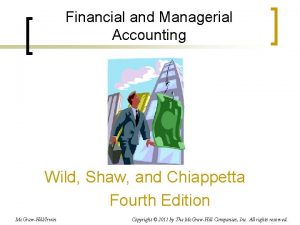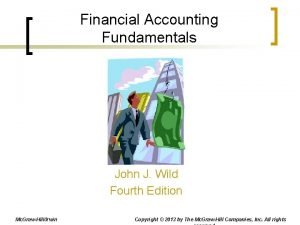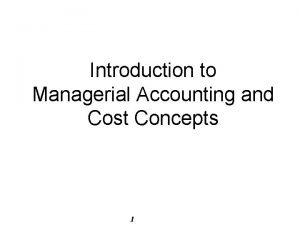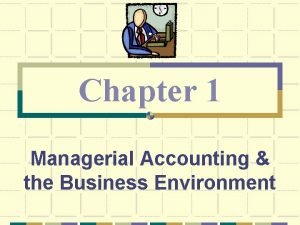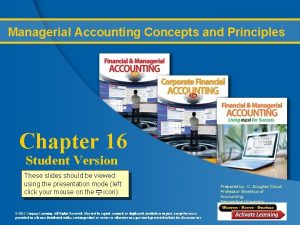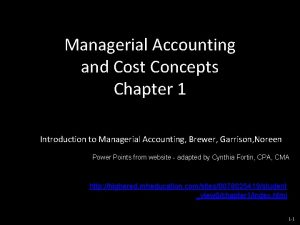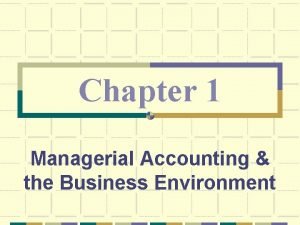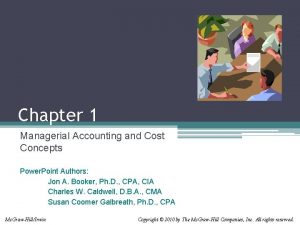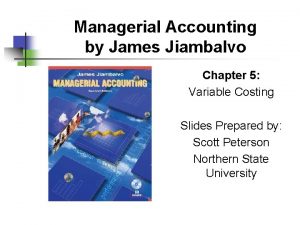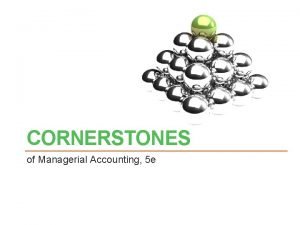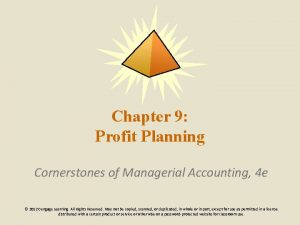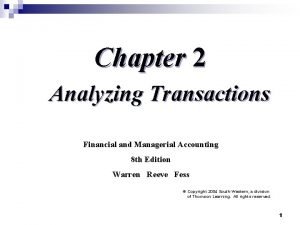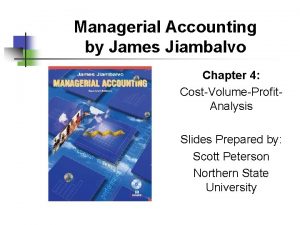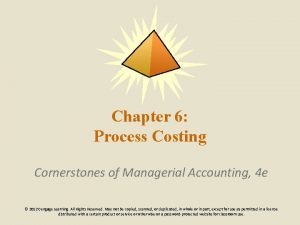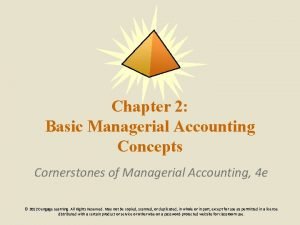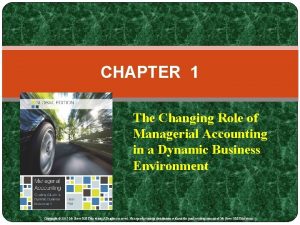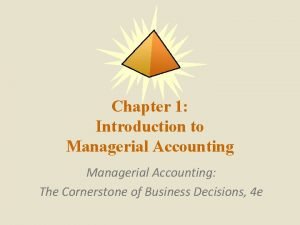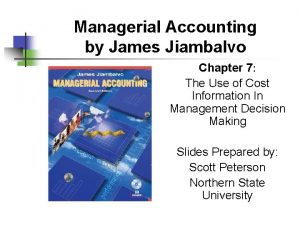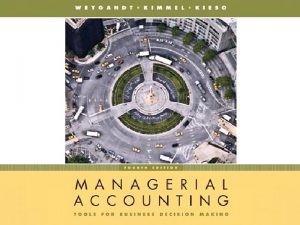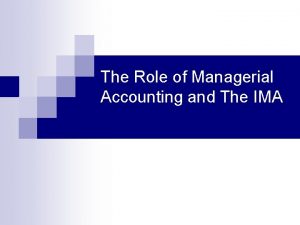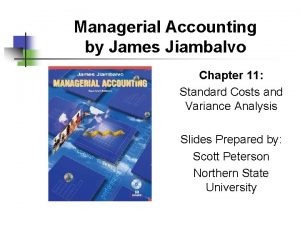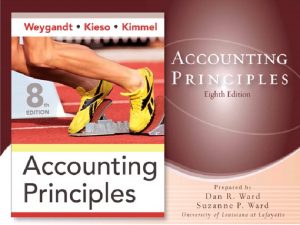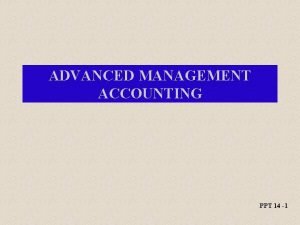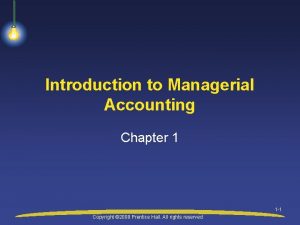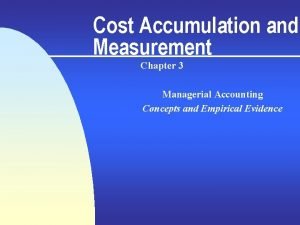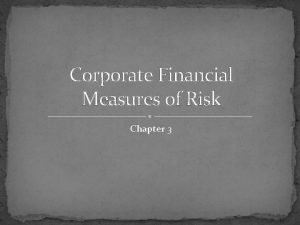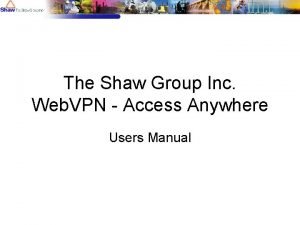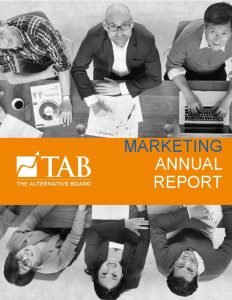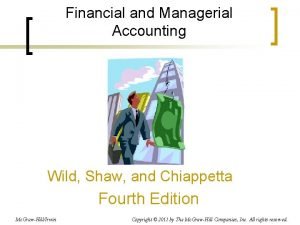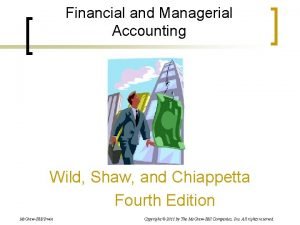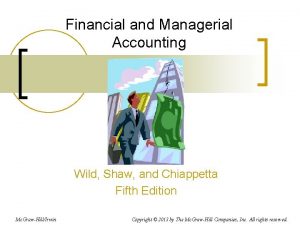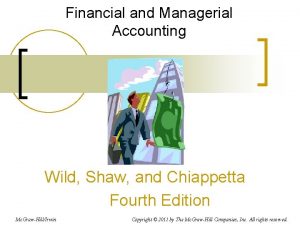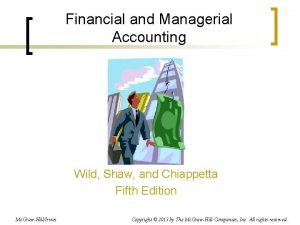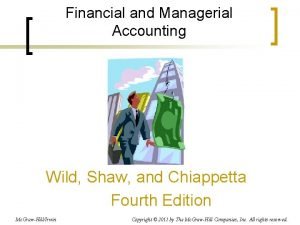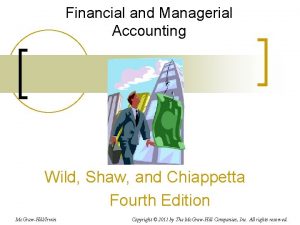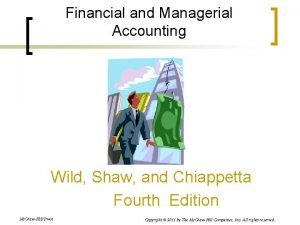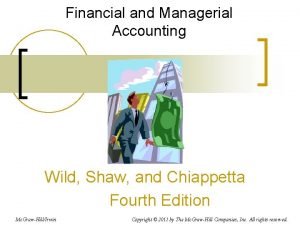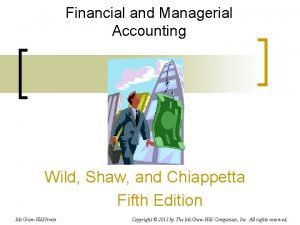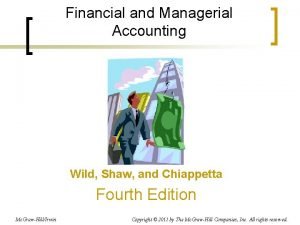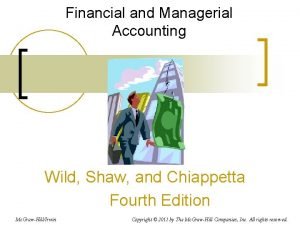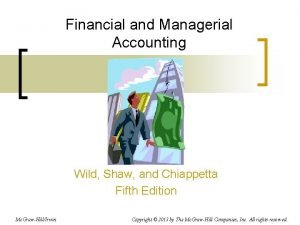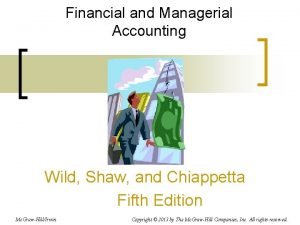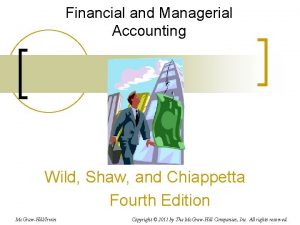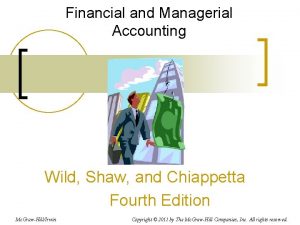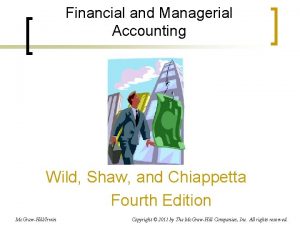Financial and Managerial Accounting Wild Shaw and Chiappetta









































- Slides: 41

Financial and Managerial Accounting Wild, Shaw, and Chiappetta Fourth Edition Mc. Graw-Hill/Irwin Copyright © 2011 by The Mc. Graw-Hill Companies, Inc. All rights reserved.

Chapter 2 Analyzing and Recording Transactions

Conceptual Learning Objectives C 1: Explain the steps in processing transactions. C 2: Describe an account and its use in recording transactions. C 3: Describe a ledger and a chart of accounts. C 4: Define debits and credits and explain double-entry accounting. 2 -3

Analytical Learning Objectives A 1: Analyze the impact of transactions on accounts and financial statements. A 2: Compute the debt ratio and describe its use in analyzing financial condition. 2 -4

Procedural Learning Objectives P 1: Record transactions in a journal and post entries to a ledger. P 2: Prepare and explain the use of a trial balance. P 3: Prepare financial statements from business transactions. 2 -5

C 1 Analyzing and Recording Process Exchanges of economic consideration between two parties. External Transactions occur between the organization and an outside party. Internal Transactions occur within the organization. 2 -6

C 1 Analyzing and Recording Process Analyze each transaction and event from source documents Prepare and analyze the trial balance Record relevant transactions and events in a journal Post journal information to ledger accounts 2 -7

C 1 Source Documents Checks Employee Earnings Records Bills from Suppliers Purchase Orders Bank Statements Sales Tickets 2 -8

C 2 The Account and its Analysis An account is a record of increases and decreases in a specific asset, liability, equity, revenue, or expense item. The general ledger is a record containing all accounts used by the company. 2 -9

C 2 The Account and its Analysis Assets Asset Accounts = Liability Accounts + Equity Accounts 2 -10

C 3 Asset Accounts Cash Land Buildings Asset Accounts Receivable Notes Receivable Prepaid Accounts Equipment Supplies 2 -11

C 3 Liability Accounts Payable Notes Payable Liability Accounts Accrued Liabilities Unearned Revenue 2 -12

C 3 Equity Accounts Retained Earnings Common Stock Dividends Equity Accounts Revenues Expenses 2 -13

C 3 The Account and its Analysis Assets + Common Stock = Liabilities – Dividends + + Revenues Equity – Expenses 2 -14

C 3 Ledger and Chart of Accounts The ledger is a collection of all accounts for an information system. A company’s size and diversity of operations affect the number of accounts needed. The chart of accounts is a list of all accounts and includes an identifying number for each account. 2 -15

C 4 Debits and Credits A T-account represents a ledger account and is a tool used to understand the effects of one or more transactions. 2 -16

C 4 Double-Entry Accounting Assets ASSETS Debit + Credit - = Liabilities LIABILITIES Debit - Credit + + Equity EQUITIES Debit - Credit + 2 -17

Double-Entry Accounting C 4 Equity Common Stock _ Dividends + Revenues _ Expenses Stock Dividends Revenues Expenses Debit Credit - + + - 2 -18

C 4 Double-Entry Accounting An account balance is the difference between the increases and decreases in an account. Notice the T-Account 2 -19

P 1 Journalizing and Posting Transactions Assets Step 1: Analyze transactions and source documents. Step 4: Post entry to ledger = Liabilities + Equity Step 2: Apply doubleentry accounting Step 3: Record journal entry 2 -20

P 1 Journalizing Transactions ŒTransaction Date Transaction explanation Titles of Affected Accounts Dollar amount of debits and credits 2 -21

P 1 Balance Column Account T-accounts are useful illustrations, but balance column accounts are used in practice. 2 -22

P 1 1 Posting Journal Entries Identify the debit account in ledger. 2 -23

Posting Journal Entries P 1 2 Enter the date. 2 -24

P 1 3 Posting Journal Entries Enter the amount and description. 2 -25

P 1 4 Posting Journal Entries Enter the journal reference. 2 -26

P 1 5 Posting Journal Entries Compute the balance. 2 -27

P 1 Posting Journal Entries 6 Enter the ledger reference. 2 -28

A 1 Analyzing Transactions Analysis: Double entry: Posting: 101 301 2 -29

A 1 Analyzing Transactions Analysis: Double entry: Posting: 126 101 2 -30

A 1 Analyzing Transactions Analysis: Double entry: Posting: 167 101 2 -31

A 1 Analyzing Transactions Analysis: Double entry: Posting: 126 201 2 -32

A 1 Analyzing Transactions Analysis: Double entry: Posting: 403 101 2 -33

P 2 Trial Balance Fast. Forward Trial Balance December 31, 2011 Cash Accounts receivable Supplies Prepaid Insurance Equipment Accounts payable Unearned consulting revenue Common stock Dividends Consulting revenue Rental revenue Salaries expense Rent expense Utilities expense Total Debits $ 4, 350 9, 720 2, 400 26, 000 Credits $ 6, 200 3, 000 30, 000 200 5, 800 300 1, 400 1, 000 230 $ 45, 300 After processing its remaining transactions for December, Fast. Forward’s trial balance is prepared. The trial balance lists all account balances in the general ledger. If the books are in balance, the total debits will equal the total credits. 2 -34

P 2 Six Steps for Searching for and Correcting Errors If the trial balance does not balance, the error(s) must be found and corrected. Verify that the trial balance columns are correctly added. Recompute each account balance in the ledger. Verify that account balances are correctly entered from the ledger. Verify that each journal entry is properly posted. See whether a debit (or credit) balance is mistakenly listed as a credit (or debit). Verify that each original journal entry has equal debits and credits. 2 -35

P 3 Using a Trial Balance to Prepare Financial Statements Point in Time Period of Time Point in Time Income Statement of Retained Earnings Beginning Balance Sheet Statement of Cash Flows Ending Balance Sheet 2 -36

P 3 Income Statement 2 -37

P 3 Statement of Retained Earnings 2 -38

P 3 Balance Sheet 2 -39

A 2 Debt Ratio o Describes the relationship between the amounts of the company’s liabilities and assets. o Helps to assess the risk that a company will fail to pay its debts. 2 -40

End of Chapter 2 2 -41
 Financial and managerial accounting wild
Financial and managerial accounting wild Financial and managerial accounting weygandt kimmel kieso
Financial and managerial accounting weygandt kimmel kieso Financial accounting wild
Financial accounting wild Mrs wild going wild
Mrs wild going wild Butch killian into the wild
Butch killian into the wild Intermediate accounting chapter 1
Intermediate accounting chapter 1 Management accounting vs financial accounting ppt
Management accounting vs financial accounting ppt Managerial accounting and cost concepts
Managerial accounting and cost concepts Managerial accounting and the business environment
Managerial accounting and the business environment Accounting principles and concepts
Accounting principles and concepts Relevant range managerial accounting
Relevant range managerial accounting Managerial accounting and the business environment
Managerial accounting and the business environment Chapter 1 managerial accounting and cost concepts
Chapter 1 managerial accounting and cost concepts Define management accounting
Define management accounting Managerial accounting chapter 5 solutions
Managerial accounting chapter 5 solutions Managerial accounting chapter 13 solutions
Managerial accounting chapter 13 solutions Planning in managerial accounting
Planning in managerial accounting Chapter 2 solutions managerial accounting
Chapter 2 solutions managerial accounting Jiambalvo managerial accounting
Jiambalvo managerial accounting Managerial accounting chapter 6
Managerial accounting chapter 6 Prime cost in accounting
Prime cost in accounting Role of managerial accounting
Role of managerial accounting Focus of managerial accounting
Focus of managerial accounting Managerial accounting jiambalvo
Managerial accounting jiambalvo Chapter 1 managerial accounting
Chapter 1 managerial accounting Managerial accounting
Managerial accounting Managerial accounting james jiambalvo
Managerial accounting james jiambalvo The nature of management accounting
The nature of management accounting Cost theory and estimation
Cost theory and estimation Distinguishing features of managerial accounting
Distinguishing features of managerial accounting Distinguishing features of managerial accounting
Distinguishing features of managerial accounting Introduction to managerial accounting ppt
Introduction to managerial accounting ppt Managerial accounting skills are ______.
Managerial accounting skills are ______. Cost accumulation
Cost accumulation Dol managerial accounting
Dol managerial accounting Spoken english and broken english g.b. shaw summary
Spoken english and broken english g.b. shaw summary Shaw vpn
Shaw vpn Shaw construction
Shaw construction Pygmalion historical context
Pygmalion historical context Dr fiona shaw
Dr fiona shaw Jodie shaw page 3
Jodie shaw page 3 Sasha shaw
Sasha shaw
